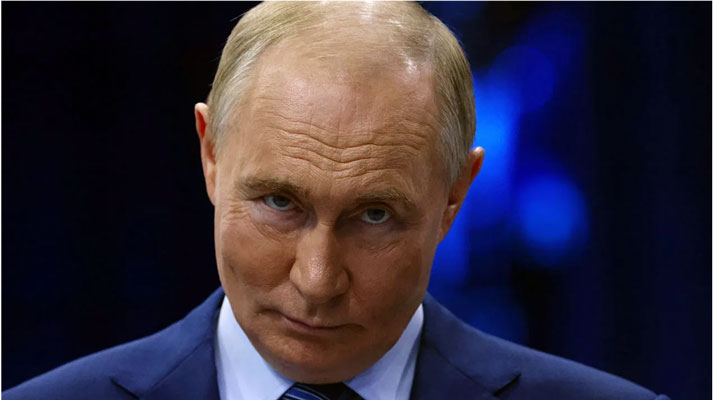Column By Mike Bibb
“For what shall it profit a man, if he shall steal the whole world, but gets blown to bits in the process?”
Mapk 8:36, New Revised Russian Bible, King Pootin Version.
It’s no secret that the country of Russia, and whatever name it’s been known by, has been involved in various conflicts for hundreds and hundreds of years.
It seems like they’re always fighting someone — even themselves. Numerous rulers and strongmen have tangled with neighbors, perceived enemies, and wannabe internal bosses (“Rukovoditel” – I think is the term).
Nowadays, the Numero Uno Dude is called President.
Or, his friends may say “Vlad” — the ones he hasn’t tossed through open windows of a 20-story building.
Now, he’s eyeballing various regions around western Russia: Ukraine, Estonia, Poland, Belarus, and a few others. He’s also badmouthing the United States.
Visions of rebuilding the old Russian Empire must be dancing in his head. Subduing Ukraine has not proven as easy as previously thought, no more so than the Soviets’ 10-year failed excursion into Afghanistan in the 1980s.
Again, thanks in large part to American money, missiles, and guns.
However, Mr. Vladimir Putin has to overcome several problems: European resistance, the United States, and Russia’s manufacturing inadequacy.
I don’t believe he cares much about what the United Nations thinks, does, or doesn’t do.
While Europe has historically been its worst enemy — occasionally mixing with each other and currently experiencing the frustrations of open borders — Russia’s leaders have maintained a semi-unified cohesion.
Particularly, since the fall of the Czarist regimes to Communism in the early 1900s and surviving the onslaught of Adolph Hitler’s WWII army.
Simply, if Russian dictators weren’t murdering their own people, Hitler was. At least, temporarily.
Which, as it turned out, was due in large part to Hitler’s stupid blunders and the generosity of the United States supplying military hardware and supplies to Moscow through an agreement called “Lend-Lease.”
Of course, the U.S. entry, along with its allies, overcame Adolph’s delusional ambitions to conquer Europe and the Soviet Union.
But that was 85 years ago, and weapons of war and advancing technology have dramatically altered tactics and strategy.
However, the game plan remains the same — Divide and Conquer.
Agreements are sometimes fabricated among enemies to achieve these goals. Today, China and Russia are pseudo-pals, a shaky affiliation built upon the notion that neither one could whip the United States alone, but they’d have a better chance if they teamed up.
Pretty much the same thinking in WWII when Japan, Italy, and Germany were buddies.
Regarding the numbers, Russia seems to be the weak link in the trio. With a population of about 146 million, and a GNP of $2 trillion (11th), it falls way behind the United States with 340 million people and a GNP of $30.5 trillion (1st), and China with a population of 1.4 billion people and a GNP of $19.7 trillion (2nd).
By realistic standards, Russia doesn’t have the economy or workforce to sustain a belligerent encounter with opposing forces. Maintaining a prolonged war footing requires money, factories, and soldiers.
Supposedly, it has an intimidating nuclear arsenal.
So does the United States.
China, to a lesser extent.
So, why would Putin risk a world war with limited capabilities? Especially, considering his military has already been severely bruised by the Ukrainians?
He has to know launching a nuclear assault would be the end of Russia, and I doubt China would want to be dragged into the conflict, realizing a similar strike is feasible upon Beijing.
In 2025, atomic warfare is considerably more lethal and destructive than the 1945 version.
Of course, there’s always the possibility that Vlad, 73, recognizes he isn’t getting any younger. His days in office may be winding down as younger Politburo members, with “new ideas,” are waiting in the wings.
If he wants to be remembered as a latter-day Ivan the Great, who had a dramatic influence upon Russia, he must make his big move soon.
Either he seeks peace, concentrates on improving the Russian economy, and restrains his military to a defensive mode, or he doesn’t.
It’s his choice.
Or, he may go down in history books as another Russian thug seeking fame and riches. However, he may be sadly disappointed if he wakes up some morning, gazes out at a smoldering Red Square, and suddenly fathoms he should have learned the lessons of the United States’ recent aerial mission into Iran.
The planes invisibly arrived, dropped their payload, and were gone before anyone on the ground knew they were there.
No nuclear explosions melted anything or anyone—just modern conventional bombs.
I imagine the USAF could do the same thing over Moscow, if it had to.
If that doesn’t do the trick, a Cruise missile crashing through Vlad’s living room window may change his attitude!
The opinions expressed in this editorial are those of the author.










